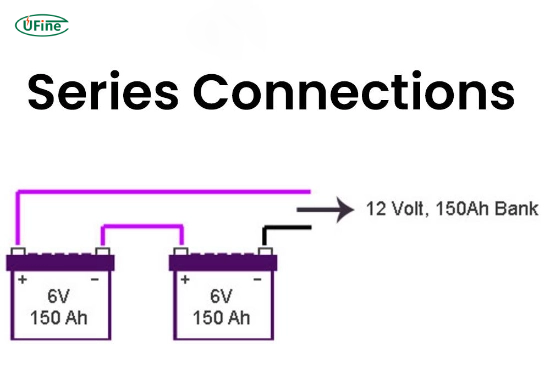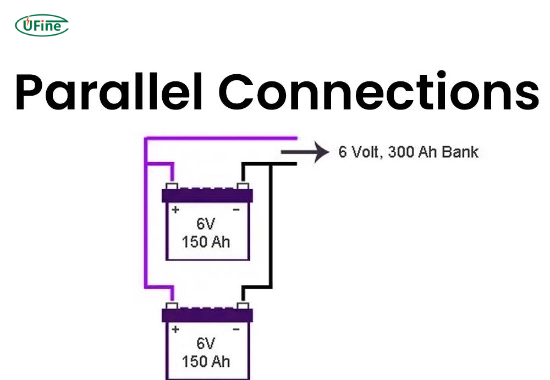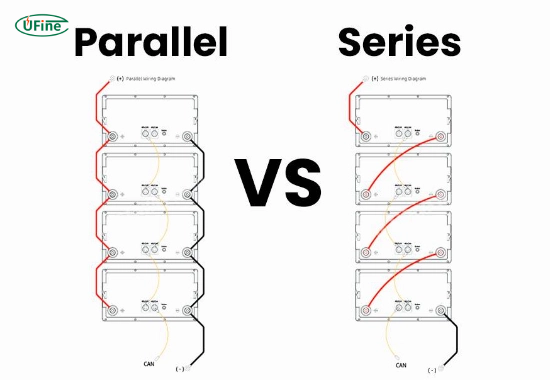Are batteries in series vs. parallel? Which is better? This article explores how we connect batteries to power things. We’ll see which way is better for different uses, keeping it simple for everyone to understand.
Batteries in Series vs Parallel: Key Differences
Batteries in series combine their voltage but retain the same capacity, making them ideal for applications needing higher voltage. Parallel connections, however, increase capacity while maintaining voltage, better suited for devices requiring longer runtime. This guide compares these configurations, offering insights on when and how to use them.
Part 1. Batteries in series
When batteries are in a series, they connect positive to negative. This adds up the voltage, but the current stays the same. For example, if you have two 1.5-volt batteries in series, you get 3 volts.
Advantages
1. Voltage Amplification:
The primary advantage is the cumulative increase in voltage. For instance, in a string of four 1.5-volt batteries connected in series, the total voltage output would be 6 volts. This configuration is vital in applications demanding higher voltages than individual batteries can provide, like in powering specific electronic devices or tools.
2. Enhanced Compatibility:
Series connections enable compatibility with devices designed to operate at specific higher voltages. It facilitates seamless integration with systems requiring a standardized voltage surpassing a single battery.
3. Uniform Current Distribution:
When connected in series, the current passing through each battery remains consistent. This consistent current flow is crucial in applications with a uniform power supply, such as in some electrical circuits or appliances, and is essential for optimal functioning.
Disadvantages
1. Overcharging and Imbalanced Discharge:
Discrepancies in charging or discharging rates among batteries can lead to imbalances. For instance, if one battery has a slightly lower capacity or experiences quicker discharge than others in the series, it might get overcharged, leading to potential damage or reduced longevity.
2. Dependency on All Batteries:
The entire series’s functionality relies heavily on each battery’s performance. If one battery fails or malfunctions, the whole circuit might collapse or underperform, impacting the overall output.
3. Limited Capacity Utilization:
Although the voltage increases, the total capacity of ampere-hours remains equivalent to that of a single battery. This configuration doesn’t enhance the overall energy storage capacity, which might be a limitation in applications requiring extended usage periods without recharging.
Part 2. Batteries in parallel
When batteries are connected side by parallel, their positive and negative parts link together. This makes a group where each battery keeps its voltage. But, the total power and how much it can do go up. For example, suppose two 1.5-volt batteries with different sizes are connected in parallel. In that case, the power stays at 1.5 volts, but how much it can do adds up – like having more power together.
Advantages
1. Increased Capacity without Altering Voltage:
Parallel connections substantially boost overall capacity without altering the voltage output. This expanded capacity is beneficial in scenarios requiring prolonged power supply without voltage adjustment, like in uninterrupted power systems (UPS) or solar energy storage.
2. Balanced Performance and Longevity:
Parallel setups enable balanced charging and discharging among batteries, ensuring consistent performance. Even if one battery possesses a slightly different capacity or performance, it doesn’t significantly impact the overall system’s efficiency. This balanced utilization extends the lifespan of batteries by preventing strain due to uneven usage, which is beneficial in applications demanding reliability over extended periods, such as in electric vehicles or renewable energy storage solutions.
3. Enhanced Redundancy and Reliability:
The redundancy provided by parallel connections ensures an uninterrupted power supply. If one battery fails or malfunctions, the others continue functioning, maintaining the power output. This feature is critical in crucial systems where continuous power is non-negotiable, such as medical equipment, telecommunications, or emergency lighting systems.
Disadvantages
1. Uniform Voltage Output:
While capacity increases, the voltage output remains that of a single battery. For specific applications requiring higher voltages, parallel connections might only be suitable with additional circuitry or series connections to achieve the desired voltage levels.
2. Complex Management Requirements:
Managing parallel-connected batteries necessitates meticulous attention to ensure consistent charging and discharging. Discrepancies in performance or capacity might lead to imbalances over time, necessitating active monitoring and maintenance, especially in larger systems like grid energy storage or complex backup power systems.
3. Compatibility Challenges:
Some devices might not be compatible with parallel connections due to their reliance on standardized voltage levels. In such cases, series connections might be preferable to meet the device’s voltage requirements without compromising performance.
Part 3. Comparison: Batteries in series vs. parallel
Voltage, Capacity, and Current Analysis
Voltage:
- Series Connection: Batteries in series result in cumulative voltage, where the total voltage equals the sum of individual battery voltages. For instance, linking three 1.5-volt batteries in series produces a total output of 4.5 volts.
- Parallel Connection: Parallel batteries maintain the same voltage as an individual battery. If three 1.5-volt batteries are connected in parallel, the output remains at 1.5 volts.
Capacity:
- Series Connection: While voltage increases, the overall capacity remains unchanged. A series connection retains the capacity of a single battery. For example, three 1000mAh batteries in the series still offer a total capacity 1000mAh.
- Parallel Connection: Parallel connections result in increased total capacity. Combining batteries in parallel adds up their capabilities. Three 1000mAh batteries in similar offer a full capacity of 3000mAh.
Current:
- Series Connection: Current remains constant across all batteries in the series—the same current flows through each battery.
- Parallel Connection: In a similar, each battery contributes to the total current. As a result, the overall current capacity increases with the number of batteries connected in parallel.
Applicability and Examples
- Series Connection: Ideal for applications requiring higher voltage levels. For instance, in devices needing 6 volts or more, series connections provide the necessary voltage without additional circuitry.
- Parallel Connection: Suited for applications demanding increased capacity or longer runtimes without altering voltage levels, such as in backup power systems or energy storage units.
- Series Over Parallel: In scenarios necessitating higher voltages, like in some electronics or tools, series connections excel due to their ability to increase voltage without additional components cumulatively.
- Parallel Over Series: Parallel connections shine in applications requiring prolonged power supply without modifying voltage. For instance, in electric vehicles, where longer runtimes are critical, parallel connections offer increased capacity without escalating voltage.
Quick Comparison Table
| Aspect | Batteries in Series | Batteries in Parallel |
|---|---|---|
| Voltage | Sum of individual voltages | Equal to a single battery |
| Capacity (mAh) | Same as a single battery | Sum of individual capacities |
| Applications | Devices needing higher voltage (e.g., tools, electronics) | Devices needing longer runtime (e.g., UPS, solar storage) |
| Redundancy | Fails if one battery fails | System continues functioning even if one battery fails |
Part 4. Practical applications of series and parallel connections
Understanding when to use series or parallel battery connections can save time and optimize performance:
- Series: Ideal for devices requiring high voltage, such as electric tools, flashlights, or appliances with a specific voltage requirement.
- Parallel: Suited for applications needing longer runtime, like power banks, solar energy systems, or electric vehicles.
- Combined Use: Some systems use both configurations together, such as in large solar grids, to achieve both high voltage and extended capacity.
Part 5. How to connect batteries in series?
Materials Needed
- Batteries: Ensure the batteries have the same type, voltage rating, and capacity.
- Connecting Wires: Use appropriate wires capable of handling the current without overheating or voltage drop.
Step-by-Step Process
- Inspect Batteries: Check the batteries for compatibility, ensuring they are of the same type, voltage, and capacity. Mismatched batteries can lead to imbalances and safety hazards.
- Identify Terminals: Each battery has a positive (+) and a negative (-) terminal. Identify these terminals on all batteries before proceeding.
- Connect Positive to Negative: Take the first battery and connect the positive terminal (+) to the second battery’s negative terminal (-). Repeat this process for subsequent batteries in the series, combining the positive terminal of one battery with the negative terminal of the next.
- Secure Connections: Use appropriate connecting wires to link the terminals securely. Ensure the connections are tight and well-insulated to prevent short circuits or accidental disconnections.
- Verify the Configuration: Double-check the connections to ensure they are in the desired series configuration. A series connection results in a chain-like arrangement where the positive terminal of the first battery is connected to the negative terminal of the last battery.
- Test the Setup: Before deploying the series-connected batteries, test the voltage output using a multimeter to ensure it aligns with the expected cumulative voltage. Ensure all connections are secure and the circuit is functioning correctly.
- Implement Safety Measures: Always prioritize safety when working with batteries. Avoid short circuits, handle batteries cautiously, and adhere to proper safety protocols while handling electrical components.
Part 6. How to connect batteries in parallel?
Materials Needed
- Batteries: Ensure the batteries have the same type, voltage rating, and capacity for optimal performance.
- Connecting Cables: Use appropriate cables capable of handling the current without overheating or voltage drop.
Step-by-Step Process
- Battery Compatibility Check: Ensure all batteries to be connected in parallel are of the same type, voltage, and capacity. Mismatched batteries can lead to imbalances and reduced efficiency.
- Identify Terminals: Each battery has a positive (+) and a negative (-) terminal. Identify and distinguish these terminals on all batteries before beginning the connection process.
- Group Positive Terminals: Take all batteries and connect their positive terminals (+) using connecting cables. This creates a junction where all positive terminals are linked.
- Group Negative Terminals: Connect all negative terminals (-) using separate cables. This forms another junction where all negative terminals are joined.
- Secure Connections: Ensure all connections are tight and well-insulated to prevent short circuits or accidental disconnections. Use appropriate cables and connectors rated for the current capacity.
- Verify Configuration: Double-check the connections to ensure all positive and negative terminals are connected. In a parallel setup, positive terminals are linked together, as are negative terminals.
- Testing Phase: Before deploying the parallel-connected batteries, test the overall capacity using appropriate tools to ensure the expected cumulative capacity aligns with the calculations.
- Safety Precautions: Always prioritize safety when handling batteries. Avoid short circuits, take batteries carefully, and follow safety protocols while working with electrical components.
Part 7. FAQs
-
What is the main difference between series and parallel battery connections?
Series connections increase voltage, while parallel connections increase capacity. Choose series for devices requiring higher voltage and parallel for longer battery runtime. -
Which is better for my application: series or parallel batteries?
It depends on your needs: series is better for higher voltage requirements, and parallel is better for devices needing extended runtime. -
Can I mix batteries of different capacities or types in series or parallel?
No, mixing different batteries can lead to imbalances and reduced performance. Always use batteries with the same type, voltage, and capacity. -
Do batteries last longer in series or parallel?
Batteries in parallel last longer as they share the load and increase total capacity. Series connections maintain capacity but provide higher voltage. -
What happens if one battery fails in series or parallel?
In series, the entire system may fail due to dependency. In parallel, other batteries can continue working, but overall capacity will decrease.
Related Tags:
More Articles

Paper Battery vs. Flexible Battery: What’s the Difference and Which Is Better?
Paper vs. flexible batteries: learn the key differences, benefits, and which power source fits best for wearables, sensors, and smart tech.
What to Know Before Buying a Tiny LiPo Battery for Your Project
Tiny LiPo batteries are powerful and compact. Learn how to choose the right one for your project with specs, safety, and charging tips.
Bloated LiPo Battery: Will It Explode?
Will a bloated LiPo battery explode? Discover the causes, risks, safety steps, and expert tips to avoid disaster and protect your gear. Must-read safety guide!
12V 100Ah Lithium Ion Battery Price: Full Guide
Learn about 12V 100Ah lithium-ion battery price, from cost ranges to best brands, hidden fees, and how to get the best deal. A must-read for smart buyers!
Resistance and Conductivity: What It Means for Your Lithium Batteries
Resistance and conductivity impact lithium battery performance, lifespan, and safety—learn how they work and why they matter.






